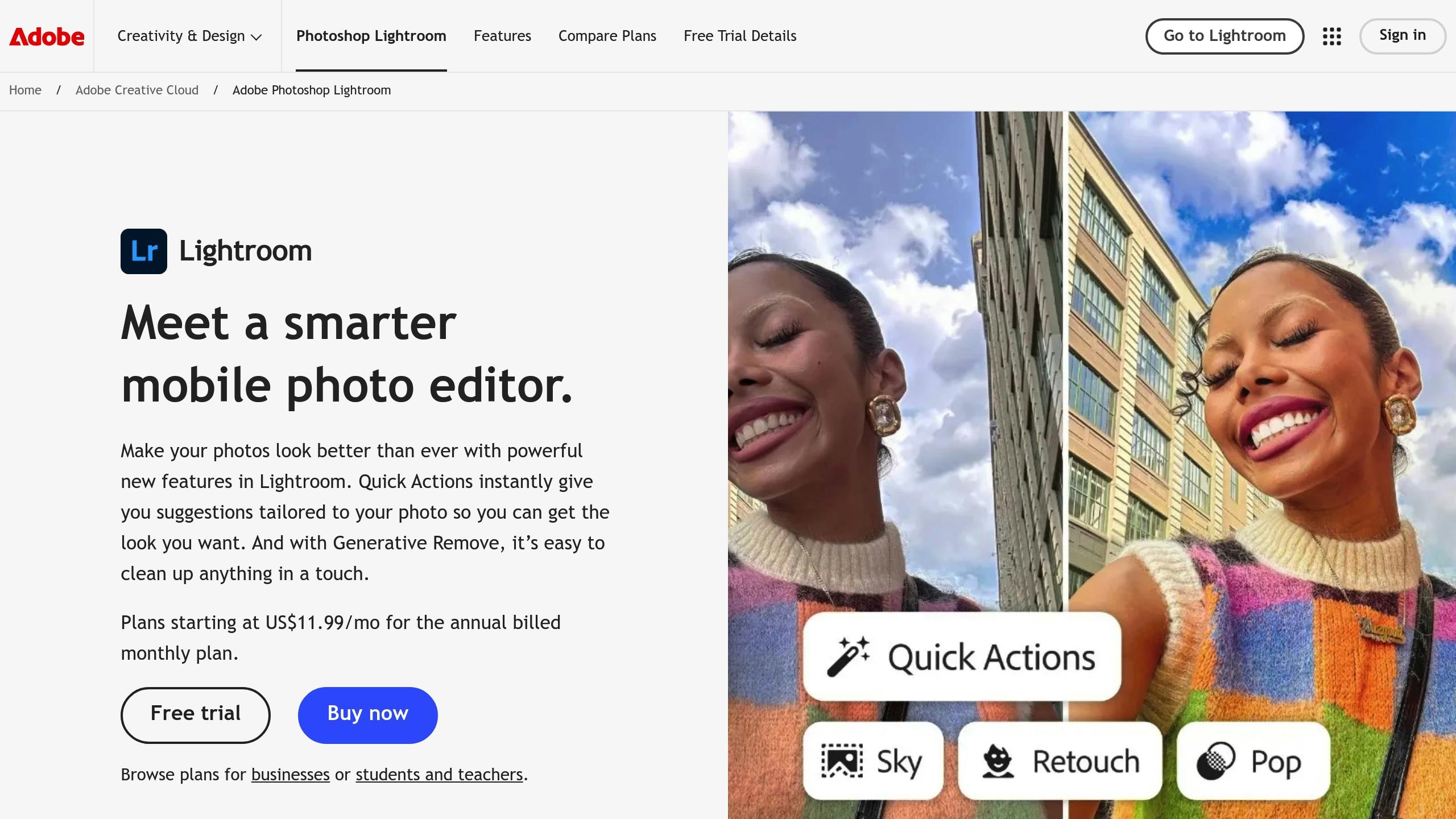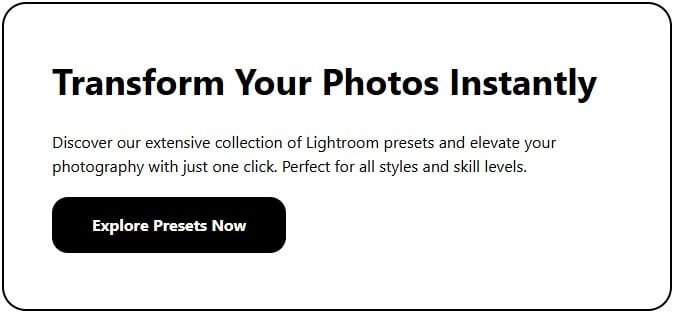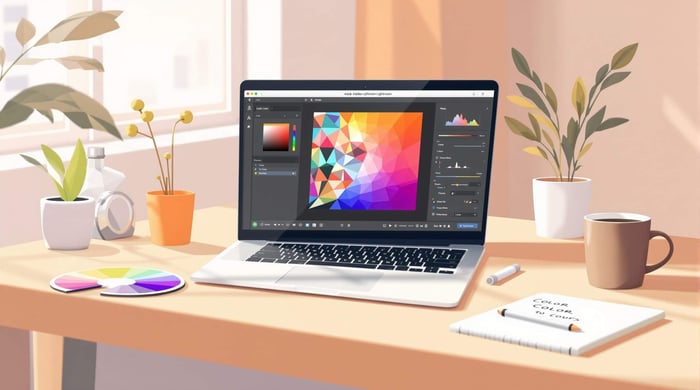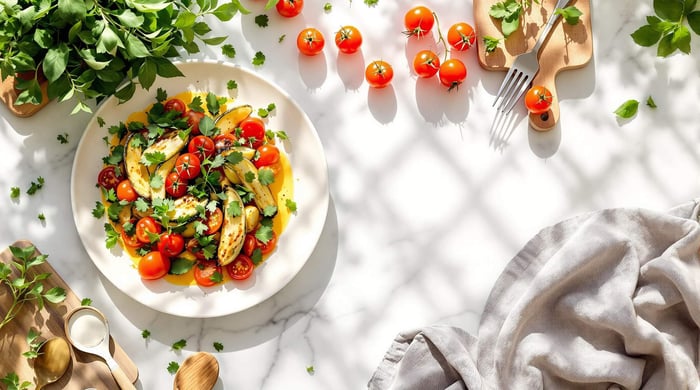Understanding Color Theory in Photography (And How Presets Can Help)
Mastering color theory can transform your photography. Whether you're aiming to create vibrant landscapes, moody portraits, or professional edits, understanding how colors interact is key. Here's a quick rundown:
- Color Theory Basics: Learn how primary, secondary, and tertiary colors combine to create complementary, analogous, triadic, or monochromatic schemes.
- Color and Mood: Warm colors (reds, yellows) grab attention and feel energetic, while cool colors (blues, greens) evoke calm and depth.
- Digital Editing: Tools like Lightroom presets simplify color adjustments, helping you apply hue, saturation, and luminance tweaks quickly.
- Presets in Action: Use presets for split toning, HSL modifications, and color grading to achieve consistent, polished results.
- Practical Tips: Adjust white balance, test different presets for various scenes, and refine details for natural, professional-looking edits.
Key Takeaway: Mastering color theory and using presets can save time, improve consistency, and elevate your photography's visual impact.
Color Theory Core Concepts
Color Wheel Basics
The foundation of understanding color combinations traces back to Newton's 1666 work [1]. Later, Johannes Itten developed the color wheel, which organizes colors into three main groups:
- Primary Colors: Red, yellow, and blue – the base colors that can't be created by mixing others.
- Secondary Colors: Orange, green, and purple – made by mixing two primary colors.
- Tertiary Colors: Blends like blue-green or red-orange, created by mixing a primary and a secondary color.
Here are some popular color schemes and their effects:
| Color Scheme | Description | Effect in Photography |
|---|---|---|
| Complementary | Opposite colors on the wheel | Strong contrast and dynamic visual energy |
| Analogous | Neighboring colors | Smooth harmony and natural flow |
| Triadic | Three evenly spaced colors | Balanced yet bold compositions |
| Monochromatic | Variations of one color | Unified and focused aesthetic |
This framework helps photographers understand how colors can shape mood and atmosphere.
Color and Mood
Our eyes are naturally drawn to warm colors, as 64% of cones are sensitive to red light [1].
Warm Colors (red, orange, yellow):
These colors tend to stand out in a composition, creating energy and drawing attention to the foreground. They often evoke feelings of excitement and intensity.Cool Colors (blue, green, purple):
These shades tend to fade into the background, bringing a sense of calm and depth. They can create a tranquil, distant feel in a scene.
These principles form the basis for how colors are applied in digital tools today.
Digital Color Systems
Modern photo editing relies heavily on two key color models:
RGB (Red, Green, Blue)
This additive model is used for digital screens and online content. When all three colors are combined at full intensity, they produce white light. RGB offers the widest range of vibrant colors for digital photography [2].
CMYK (Cyan, Magenta, Yellow, Black)
Used primarily for printing, this subtractive model produces more muted tones. Understanding when to use RGB versus CMYK is essential for preparing images for either digital or print formats [2].
"Perception is reality, and color is perception." - Nate Torres [2]
To ensure accurate color representation, photographers should:
- Regularly calibrate their monitors to maintain consistency.
- Edit with the intended output in mind - whether for print or digital use.
- Pay attention to color profiles when exporting images to avoid unexpected shifts.
Color Theory in Practice
Camera Color Techniques
Getting the right color balance starts when you take the shot, not just during editing. Understanding how lighting and scene elements influence color relationships is crucial. Aim to create intentional color combinations that support the story you're telling.
Warm colors, like reds and oranges, naturally grab attention because our eyes are more sensitive to them. Use this to your advantage by placing warm-toned elements in front of cooler backgrounds. This creates a sense of depth, as warm colors seem to pop forward while cool ones fade into the background.
Here’s a quick guide to how lighting conditions affect colors and how to adjust your shooting techniques:
| Lighting Condition | Effect on Colors | Shooting Technique |
|---|---|---|
| Golden Hour | Boosts warm tones | Position subjects to catch soft, golden light |
| Blue Hour | Highlights cool tones | Ideal for creating moody, atmospheric shots |
| Midday Sun | Creates high contrast | Lower saturation directly in-camera |
| Overcast | Mutes colors | Increase vibrancy during the shoot |
These techniques lay the groundwork for easier editing later on.
"Color harmony is a theory of combining colors to create a mixture that is pleasing to the eyes. It represents balance and unity of colors." - fotographee.com
Color Editing Methods
Once you’ve nailed the in-camera colors, editing can fine-tune and elevate your images.
- Hue Adjustments: Change specific colors without affecting others. For instance, tweak blue skies toward cyan for a tropical vibe while keeping skin tones natural.
- Saturation Control: Let one color stand out while using its complementary color as a subtle accent.
- Luminance Manipulation: Adjust the brightness of individual colors to add depth. For example, darkening blues in a sky can make warmer foreground elements pop [1].
- Color Temperature: Adjust white balance to shift the mood. Warmer tones (higher Kelvin) create vibrant, energetic scenes, while cooler tones set a calm, dramatic atmosphere [3].
Color grading can completely change the emotional tone of your image. Warm tones feel lively and engaging, cool tones bring calm and distance, desaturated colors add nostalgia, and high contrast amps up the drama.
"Warm colors are thought to advance, stimulating, stand out or appear more active in an image. Cool colors tend to recede, calming, convey a sense of distance or serve as a background color." - fotographee.com
Using Lightroom Presets for Color
Quick Color Edits with Presets
Lightroom presets offer a quick way to apply color adjustments based on established editing techniques. With just a click, these presets apply adjustments grounded in color theory, helping you create visually appealing results.
Presets typically adjust the following key areas:
| Adjustment Type | Impact on Image | Common Uses |
|---|---|---|
| Split Toning | Adds depth by coloring highlights and shadows differently | Cinematic effects, enhancing sunsets |
| HSL Modifications | Tweaks specific color ranges | Correcting skin tones, seasonal edits |
| Color Grading | Creates consistent color themes | Setting moods, ensuring brand alignment |
| White Balance | Adjusts overall color temperature | Simulating different times of day, creating atmosphere |
Once you apply a preset, you can fine-tune details to better match your intended style or mood.
Preset Adjustments
Here are some techniques to refine presets for the best results:
- Temperature Tweaks: Adjust the white balance slightly (±5-10 points) to keep skin tones natural while aligning with your creative color choices.
- Selective Color Changes: Use the HSL panel to tweak specific colors without altering the overall look. For instance, boosting blue saturation by 15-20 points can make skies more vibrant.
- Tone Adjustments: Modify exposure and contrast to enhance the preset's effect. A small contrast boost (+5-10) can make colors stand out more effectively.
These small adjustments allow you to fine-tune your images while staying true to your creative vision.
Preset Examples
Different presets work best for specific scenarios. Here’s how they can address common challenges:
| Scene Type | Challenge | Solution |
|---|---|---|
| Golden Hour Portraits | Balancing warm light with skin tones | Warm presets with slight desaturation |
| Urban Architecture | Dealing with mixed lighting | High-contrast presets with split toning |
| Nature/Landscapes | Highlighting natural color harmony | Presets with complementary colors and targeted vibrance |
| Indoor Events | Fixing artificial lighting issues | White balance-focused presets paired with HSL tweaks |
To get the best results, start with subtle adjustments (10-15% strength) and gradually increase them until you achieve the desired look. This approach ensures your edits enhance the image naturally without overwhelming the subject.
The goal of using presets is to enhance your image's color relationships while keeping the results authentic. When applied thoughtfully, presets can elevate your photos without overshadowing their original qualities.
Color Theory For Photographers & LIGHTROOM to Get Your ...
Preset Selection Guide
Building on earlier editing techniques, choosing the right preset fine-tunes your image's color and overall feel.
Matching Presets to Photos
Choose presets that align with your image's style and vision.
| Photo Type | Recommended Preset Style | Effect on Image |
|---|---|---|
| Portraits | Skin tone–focused | Enhances natural skin tones while keeping them realistic |
| Landscapes | Color vivid | Adds vibrancy to muted scenes and highlights natural features |
| Urban Scenes | Cinematic | Gives a polished, film-like appearance |
| Emotional Shots | Black and white | Strips color for a more emotional, focused impact |
Preset Adjustment Tips
Start with basic adjustments to white balance and exposure before diving into presets:
- Fine-tune white balance and exposure for a solid foundation.
- Preview how each preset changes the image.
- Adjust preset intensity to keep the effect subtle and balanced.
For portraits, focus on maintaining natural skin tones. A landscape preset might look great on scenery but could distort skin tones when applied to people. Always test presets on varied skin tones to ensure the results are flattering.
Testing Different Presets
Use a step-by-step approach to test presets effectively:
| Testing Phase | Action | Why It Matters |
|---|---|---|
| Initial Review | Hover over preset icons | Quickly preview the effect in the Navigator panel |
| Mood Assessment | Try moody vs. bright presets | Compare how different atmospheres change the image |
| Color Balance | Test vintage vs. modern looks | Check how colors work together in the overall image |
| Final Selection | Narrow down to top choices | Pick the preset that best matches your creative goal |
When trying vintage effects, experiment with a few options before committing to one style for an entire album. This keeps your edits cohesive while staying true to the image's essence.
For example, a moody preset can transform an image from dreamy to mysterious by deepening shadows and cooling tones. On the other hand, cinematic presets can add a polished, professional vibe. These techniques connect your preset choices to both creative goals and technical editing steps, helping you achieve striking color edits effortlessly.
Conclusion
Color theory plays a key role in turning photography into a powerful visual storytelling tool. Here's a quick look at how understanding color theory combined with presets can simplify your editing process.
Key Takeaways
Using presets makes applying color theory much easier. With a wide range of preset collections available, photographers can experiment with different color palettes and moods without spending hours on manual edits. Whether you're aiming for a cinematic vibe or a vintage aesthetic, presets allow for quick testing and creative exploration while ensuring consistent quality.
Here’s how presets can improve your workflow:
| Goal | How Presets Help | Workflow Impact |
|---|---|---|
| Enhance Mood | Pre-designed color harmonies | Saves time on editing |
| Maintain Style | Organized collections | Ensures a cohesive look across projects |
| Achieve Professional Results | High-quality color grading | Delivers polished photos with less effort |
Frequent preset updates ensure you stay aligned with current color trends while maintaining technical precision. With an impressive 4.8/5 star rating from 1,301 reviews [4], it's clear these tools are effective for streamlining color editing.


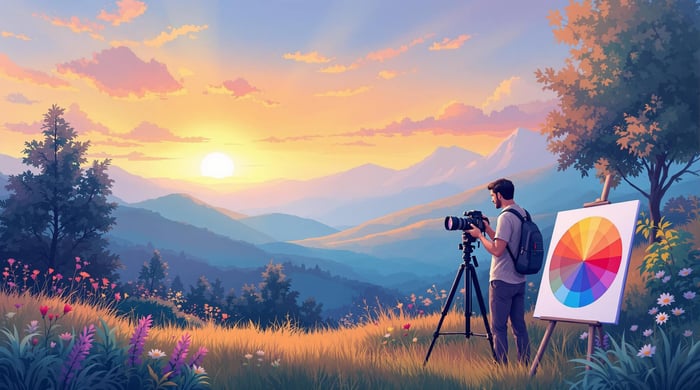
.png)
